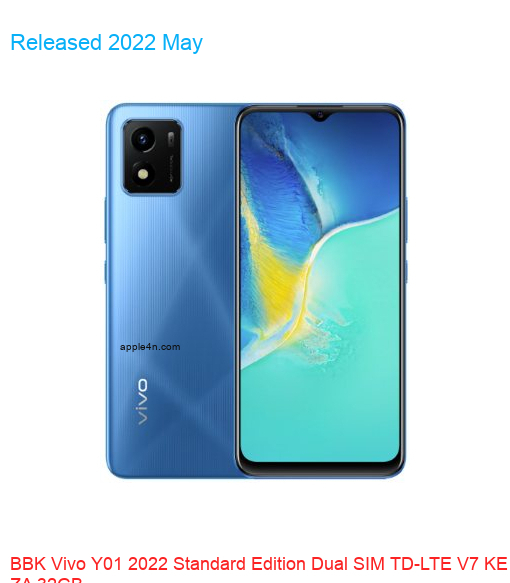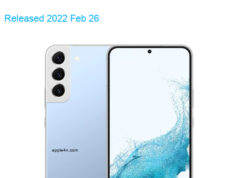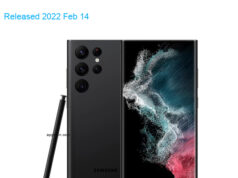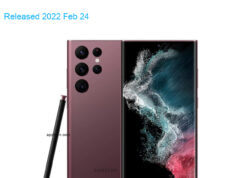| Brand | BBK |
| Model | Vivo Y01 2022 Standard Edition Dual SIM TD-LTE V7 KE TZ ZA 32GB |
| Released | 2022 May |
| Announced | 2022 Apr |
| Hardware Designer | BBK Electronics |
| Manufacturer | BBK Electronics |
| General Extras | Haptic touch feedback |
| Device Category | Smartphone |
| Width | 75.2 mm |
| Height | 163.96 mm |
| Depth | 8.28 mm |
| Dimensions | 2.96×6.46×0.33 inches |
| Mass | 178 g |
| Platform | Android |
| Operating System | Google Android 11 Go Edition (R) |
| Software Extras | Voice Command , Navigation software , Intelligent personal assistant , Face Recognition |
| CPU Clock | 2300 MHz |
| CPU | MediaTek Helio P35 MT6765, 2018, 64 bit, octa-core, 12 nm, IMG PowerVR GE8320 GPU |
| RAM Type | LPDDR3 SDRAM |
| RAM Capacity (converted) | 2 GiB RAM |
| Non-volatile Memory Interface | eMMC 5.1 |
| Non-volatile Memory Capacity (converted) | 32 GB ROM |
| Display Notch | 1-notch |
| Display Diagonal | 165.3 mm |
| Resolution | 720×1600 |
| Horizontal Full Bezel Width | 7.37 mm |
| Display Area Utilization | 82.9% |
| Pixel Density | 270 PPI |
| Display Type | Color IPS TFT LCD display |
| Number of Display Scales | 16.8M |
| Scratch Resistant Screen | Yes |
| Graphical Controller | PowerVR GE8320 |
| GPU Clock: | 600 MHz |
| A/V Out | No |
| Microphone(s) | stereo |
| Loudspeaker(s): | mono |
| Audio Output: | 3.5mm |
| Supported Cellular Bands | GSM850 , GSM900 , GSM1800 , UMTS2100 (B1) , UMTS850 (B5) , UMTS900 (B8) , LTE2100 (B1) , LTE1800 (B3) , LTE850 (B5) , LTE2600 (B7) , LTE900 (B8) , LTE800 (B20) , LTE700 (B28) , TD-LTE2600 (B38) , TD-LTE1900 (B39) , TD-LTE2300 (B40) , TD-LTE2500 (B41) bands |
| Supported Cellular Data Links | GPRS , EDGE , UMTS , HSUPA , HSDPA , HSPA+ 21.1 , LTE , LTE 100/50 , LTE 150/50 data links |
| SIM Card Slot | Nano-SIM (4FF) |
| Complementary Phone Services | Voice transmission , Voice speaker , Vibrate , Speakerphone , ANC , HD Voice , VoLTE |
| Dual Cellular Network Operation | Dual standby |
| Sec. Supported Cellular Networks: | GSM850 , GSM900 , GSM1800 , UMTS2100 (B1) , UMTS850 (B5) , UMTS900 (B8) , LTE2100 (B1) , LTE1800 (B3) , LTE850 (B5) , LTE2600 (B7) , LTE900 (B8) , LTE800 (B20) , LTE700 (B28) , TD-LTE2600 (B38) , TD-LTE1900 (B39) , TD-LTE2300 (B40) , TD-LTE2500 (B41) |
| Sec. Supported Cellular Data Links: | GPRS , EDGE , UMTS , HSUPA , HSUPA 5.8 , HSDPA , HSPA+ 21.1 , LTE , LTE 100/50 , LTE 150/50 |
| Sec. SIM Card Slot | Nano-SIM (4FF) |
| Touchscreen Type | Capacitive multi-touch screen |
| Expansion Interfaces | TransFlash , microSD , microSDHC , microSDXC |
| USB | USB 2.0 |
| USB Services | USB charging , USB Host , USB OTG 1.3 , USB PD |
| USB Connector | USB Micro-AB |
| Max. Charging Power | 10.0 W |
| Bluetooth | Bluetooth 5.0 |
| Wireless LAN | 802.11a , 802.11b , 802.11g , 802.11n , 802.11ac |
| Wireless Services | Wi-Fi Tethering , WiDi |
| FM Radio Receiver | FM radio (76-108 MHz) |
| Complementary Satellite Services | Simultaneous GPS , A-GPS , Geotagging , QuickGPS |
| Supported GLONASS protocol(s) | L1OF |
| Supported Galileo service(s) | E1 |
| Supported BeiDou system (BDS) | B1I BeiDou receiver |
| Camera Placement | Rear |
| Camera Image Sensor | BSI CMOS |
| Image Sensor Pixel Size | 1.12 micrometer |
| Number of effective pixels | 8.0 MP camera |
| Aperture (W) | f/2.00 |
| Zoom | 1.0 x optical zoom |
| Focus | PD AF |
| Flash | single LED |
| Camera Extra Functions | HDR photo , HDR video , Burst mode , Touch focus , Macro mode , Panorama Photo , Face detection , Face tagging , Smile detection , Face retouch , Intelligent scene detection |
| Aux. Camera Image Sensor | No |
| Aux. Camera Extra Functions | HDR photo , Burst mode , Macro mode |
| Aux. 2 Camera Image Sensor | No |
| Aux. 3 Camera Image Sensor | No |
| Aux. 4 Camera Image Sensor | No |
| Secondary Camera Placement | Front |
| Secondary Camera Sensor | CMOS |
| Secondary Camera Number of pixels | 4.9 MP sec. cam |
| Secondary Aperture (W) | f/2.20 |
| Secondary Camera Extra Functions | HDR photo , Panorama Photo , Face detection , Smile detection , Face retouch |
| Sec. Aux. Cam. Image Sensor | No |
| Built-in compass | Yes |
| Built-in accelerometer | Yes |
| Built-in gyroscope | Yes |
| Additional sensors | L sensor , P sensor |
| Protection from solid materials | Yes |
| Protection from liquids | Yes |
| Battery | Li-ion polymer (LiPo) |
| Nominal Battery Capacity | 5000 mAh battery |
| Market Countries | Kenya , Nigeria , South Africa , Tanzania , Uganda |
| Market Regions | Africa |
| Added | 2025-02-28 |
Specifications data description of this 📱BBK Vivo Y01 2022 Standard Edition Dual SIM TD-LTE V7 KE TZ ZA 32GB📱
Title: BBK Vivo Y01 2022 Standard Edition Dual SIM TD-LTE V7 KE TZ ZA 32GB – Full Specifications
Introduction
————
The BBK Vivo Y01 2022 Standard Edition Dual SIM TD-LTE V7 KE TZ ZA 32GB is a powerful new device in Vivo’s Y-series. Packed with impressive features and a sleek design, this phone is set to impress users looking for a high-performing device without breaking the bank. In this blog post, we will explore the lineup, design, and specifications of the BBK Vivo Y01 2022.
Lineup
——
📅 **LAUNCH**
The BBK Vivo Y01 2022 was announced in 2022 and was designed to cater to users seeking a balanced blend of style, functionality, and affordability.
Design
——
🏋️ **BODY**
The BBK Vivo Y01 2022 has a slim profile and a compact build, weighing just 175g. It fits comfortably in the hand and features a sleek, modern design that is sure to turn heads. The device is available in multiple colors, allowing users to choose one that fits their style.
Specifications
————-
🌐 **NETWORK**
The BBK Vivo Y01 2022 supports both TD-LTE and Dual SIM capabilities, making it easy for users to stay connected no matter where they are.
🤖 **OS 🛠️**
The device runs on the latest version of Vivo’s custom UI, Funtouch OS, built on top of Android, providing users with a seamless and intuitive experience.
🚀 **Chipset 🔧**
Under the hood, the BBK Vivo Y01 2022 has a powerful MediaTek chipset, ensuring smooth performance and efficient multitasking.
💪 **CPU 🖥️**
The device is powered by an Octa-core CPU, providing users with fast and responsive processing.
🎮 **GPU 💻**
The BBK Vivo Y01 2022 features a Mali GPU, capable of providing an immersive gaming experience and handling graphically demanding applications with ease.
🧠 **MEMORY 🗂️**
The device comes with a generous 32GB of internal storage and supports memory expansion via a microSD card, allowing users to store all their files and applications without worrying about space constraints.
📷 **CAMERA 🎥**
The device has a primary rear camera and a front-facing camera, both capable of delivering high-quality photos and videos. The rear camera features a range of modes and capabilities, ensuring that users can capture the perfect shot every time.
🔈 **SOUND 🎵**
The BBK Vivo Y01 2022 offers an immersive sound experience, with a powerful speaker delivering clear and loud audio.
📡 **COMMS 📶**
The device supports dual-band Wi-Fi and Bluetooth, providing users with a fast and stable internet connection.
💡 **FEATURES 🎁**
The BBK Vivo Y01 2022 includes a range of additional features, such as a side-mounted fingerprint sensor, facial recognition, and a customizable always-on display.
🔋 **BATTERY🔌**
The device has a large, long-lasting battery, allowing users to stay connected for extended periods.
Conclusion
———-
The BBK Vivo Y01 2022 Standard Edition Dual SIM TD-LTE V7 KE TZ ZA 32GB offers an impressive combination of style, functionality, and affordability. Whether you’re looking for a device for work, play, or everyday use, the BBK Vivo Y01 2022 is sure to meet your needs.
We invite readers to leave a comment below, sharing their thoughts on the device and any questions they may have. Let us know what you think!








